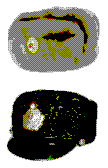
|
|
colbacks
Tipical hat of cold regions, it has been used by every rank in the army. Exclusive
colback for generals is the PAPAKHA, cylindric fleece cap, but sometimes, worty
high-ranking, officer are also allowed to use it.
Officer and troops use a colback called SHAPKA-USHANKA, with a lateral laper which
can be used as a earflaps, bottoned in the neck. For officer it's made in fur, for troops
it's made in synthetic wool.
|

|
|
helmets
SHLEM means helmet, both the rigid one and in cloth/leather. There are three types of
steel combat helmet: model Ssh40, model Ssh60 and model Ssh68. They look
considerably different: the first has curved lines and, during the years, it has been
frontally crushed, resulting now a little higher than before
More complex is the range of pilot helmets. Basic model is the ShZ-6I, in leather,with
communication disposal, consisting in a couple of earphones and a laryngealphone. In
the last models we can see oxigene mask with integrated microphones.
Here is a list of rigid helmet models:
- mod. Gsh6 hermetically sealed, used with the VKK pilot suit vin old aircraft without
pressurized cockpits;
- mod. Zsh3, a simple rigid shell that covers ShZ-6I leather helmet;
- mod. Zsh-5, the typical modern pilot-helmet, with intercom disposal.
- mod. Zsh-7, last model.
A peculiar one is the tanker helmet. Made in grey heavy cloth, has special stuffings
that soften blows. Three or four stuffed bands protect the head from the forehead till
the nape, and other bands provide lateral protection. There are two pockets containing
earphones, and a laryngealphone is used for trasmission. In some models, in the
forehead, a metal plaque supports night vision googles (PNV-57 is the most common).
Similar to the mentioned model is the jumping helmet, made in green or grey cloth,
without the intercom disposal.
|

|
|
sidecaps
The PILOTKA is the typical hat of the soviet soldier, and recall the stereotype of red
army soldier of WWII, with his PpSsh. In the last time it was replaced with a new
cloth peaked cap (with earflaps, similar to wartime japanese cap)
The sidecap is simply olive green for enlisted men, with a red board for officers (blue
board for air force). In the navy the side cap is black, white boarded for officers.
|

|
|
caps
The most common cap is called FURASKHA and it's used by every rank of army.
There are two kinds of it: one for parade and off-duty, and another for service.
The parade cap is "tsar" green for army e blue for air force. Service cap is olive green.
A band indicates the specific army: red for infantry, black for other specialities
(artillery, signals, tank corps, ...), pale blue for air force, ...
There is also a combat model, kaki coloured with olive green badge.
For the navy the colour is white for summer uniform and black for winter
In late years was re-introduced the panama hat, in kaki for Army and camo for special
troops (butan for paratroopers and klmk for KGB border guards)
|

|
|
berets/other caps
The beret (basque) is a specific hat for special troops. It's black for tanker and navy
infantry, pale blue for airborne troops (VDV). It's also used by female personnel: tsar
green for parade uniform, olive green for field uniform, white/black for navy and pale
blue for air force.
The typical sailor hat (troops and cadets) is black for winter uniform and white for
summer. A black band with golden letters indicates the belonging fleet (northern,
southern, baltic, black Sea)
|

|
|
cap badges
Here is the section of cap badge; usually enameled and metal; sometimes embroided
|






